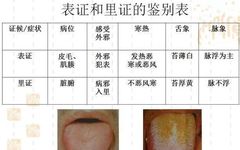 Overview of the Eight Principles
Overview of the Eight Principles
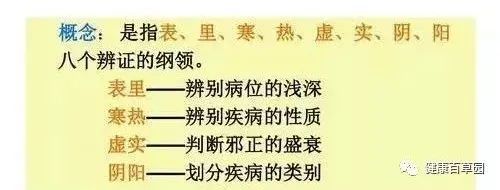
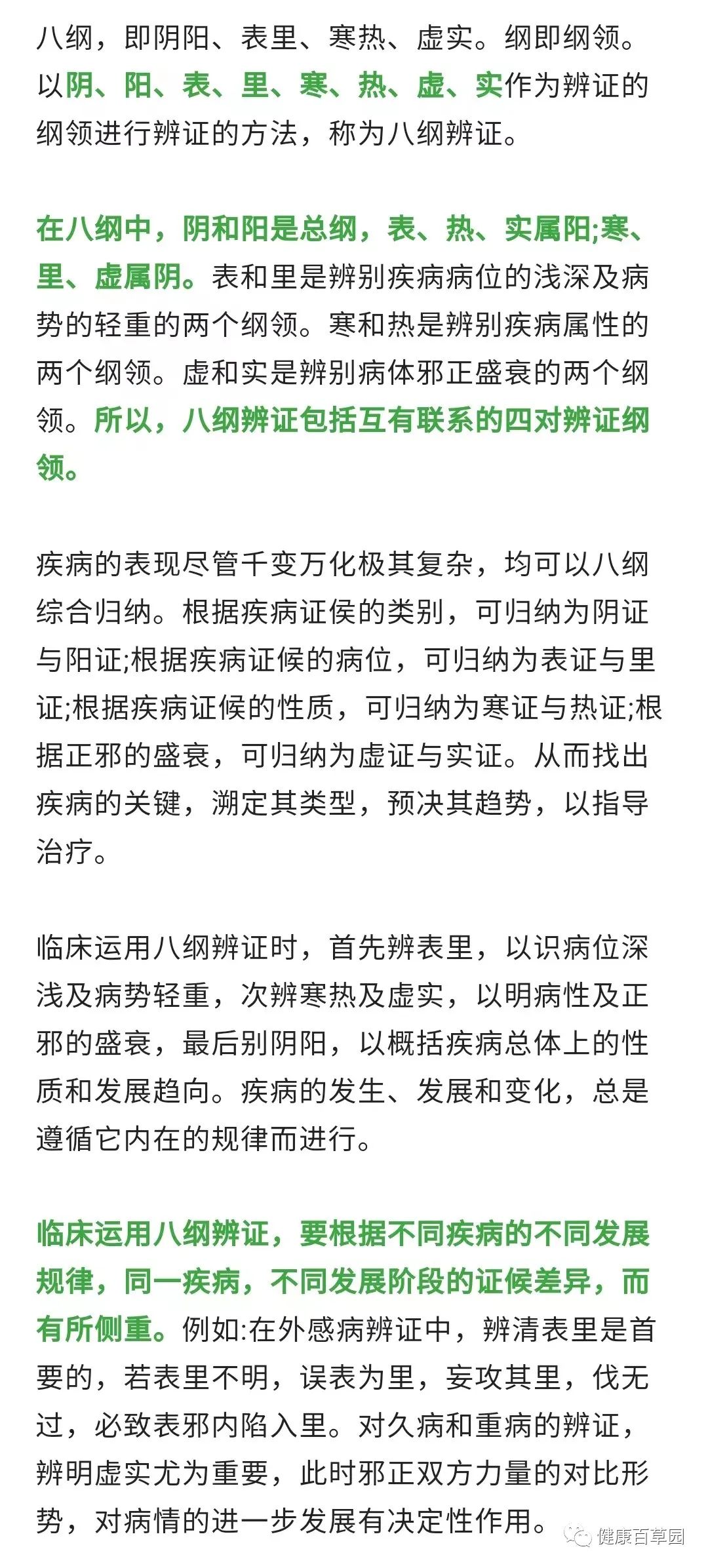
1
Exterior and Interior

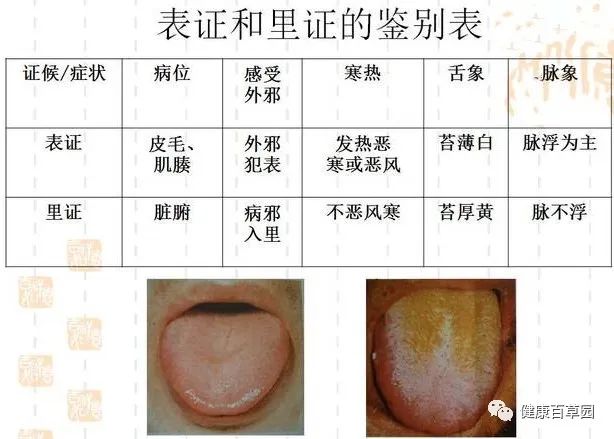
Exterior syndromes are characterized by new illness, rapid onset, short duration, and superficial location.
Interior syndromes are characterized by chronic illness, slow onset, long duration, and deep location.
In exterior syndromes, fever and chills occur simultaneously.
In interior syndromes, there may be heat without chills or chills without heat.
In exterior syndromes, the tongue coating shows no significant changes, typically thin white coating, or only the edges and tip of the tongue are red.
In interior syndromes, the tongue coating shows abnormal changes.
In exterior syndromes, the pulse is floating. In interior syndromes, the pulse is deep.
As Cheng Zhongling said: “The exterior and interior of a disease are entirely determined by fever and tidal heat, chills and heat, headache and abdominal pain, nasal congestion and dry mouth, the presence or absence of tongue coating, and the floating or deep pulse.”
Exterior and interior coexisting: This refers to the simultaneous presence of exterior and interior syndromes in a patient at a certain stage of the disease, also known as coexisting exterior and interior diseases.
Common clinical manifestations of coexisting exterior and interior diseases include exterior cold with interior heat, exterior heat with interior cold, both exterior and interior heat, both exterior and interior cold, exterior deficiency with interior excess, exterior excess with interior deficiency, both exterior and interior deficiency, and both exterior and interior excess.
Distinguishing coexisting exterior and interior diseases requires identifying which occurred first, differentiating the nature of cold and heat, and assessing the severity and urgency of the exterior and interior conditions to determine the order and specific treatment methods.
1. Both exterior and interior heat: Initially, there is internal heat, followed by an invasion of warm pathogens, presenting with fever, redness, headache, dry throat, thirst, red tongue with yellow coating, and rapid pulse, which may lead to restlessness and delirium.
2. Both exterior and interior cold: External cold invasion, with internal cold reoccurring. This may occur when there is a pre-existing deficiency of cold in the interior combined with exterior cold. Symptoms include chills, no sweating, headache, body aches, abdominal pain, vomiting, diarrhea, and cold extremities. Both exterior and interior heat and cold belong to the same qi, and treatment can focus on the interior; treating the interior can also alleviate the exterior symptoms.
3. Exterior heat with interior cold: Internal injury from cold, followed by an invasion of wind-heat, both exterior and interior belong to new pathogens. Clinical manifestations include fever with sweating, headache, cough, loose stools, clear and frequent urination, and a swollen tongue.
4. Exterior cold with interior heat: The exterior cold has not resolved, and interior heat reoccurs. Clinical manifestations include chills and fever, no sweating, headache, body aches, shortness of breath, irritability, thirst, and a floating tight pulse. For these two conditions, it is important to distinguish between exterior cold (heat) and interior heat (cold) and consider the severity and urgency of the condition to determine whether to treat the exterior or interior first. Generally, the focus should be on the exterior.
5. Both exterior and interior excess: The exterior syndrome has not resolved, while there is retained food, accumulated heat, water retention, or phlegm in the interior. Clinical manifestations include chills and fever, no sweating, headache, body aches, abdominal distension and pain upon palpation, and difficulty with urination and defecation, with a firm pulse.
6. Both exterior and interior deficiency: Spontaneous sweating, aversion to wind, dizziness, palpitations, shortness of breath, diarrhea, and weak pulse.
7. Exterior deficiency with interior excess: Spontaneous sweating, aversion to wind, abdominal fullness and pain upon palpation, thick and turbid tongue coating, and constipation.
8. Exterior excess with interior deficiency: Chills without sweating, headache, body aches, abdominal fullness with vomiting, occasional abdominal pain, and diarrhea without thirst.
The above four conditions should be treated based on the comparison of the righteous and evil forces, either treating the exterior first or the interior first, or applying treatment to both exterior and interior, weighing the urgency and severity of the conditions.
2
Cold and Heat

3
Deficiency and Excess

4
Yin and Yang
Yin and Yang are the two principles of classification. Zhang Jiebin said, “In diagnosing and treating diseases, one must first examine Yin and Yang; this is the guiding principle of medicine.”
Yin and Yang are universal laws of nature; any opposing and unifying phenomena can be classified and distinguished by Yin and Yang. Zhang Jiebin stated: “Human diseases… may originate from Yang or Yin; although the changes in diseases are numerous, their essence is singular.” Therefore, exterior, heat, and excess belong to Yang, while interior, cold, and deficiency belong to Yin. Thus, Yin and Yang serve as the two guiding principles for classifying diseases. In this sense, the scope of Yin and Yang syndromes is broad. Any syndrome can be classified as Yin or Yang, and any symptom can be analyzed as belonging to Yin or Yang.
Yin deficiency, Yang deficiency, loss of Yin, and loss of Yang are four syndromes that differ from the classification of Yin and Yang. Firstly, they all belong to deficiency syndromes; secondly, they refer to the deficiency and loss of Yin and Yang themselves. These are also four common syndromes in clinical practice.
1. Yin syndrome: Yin syndrome includes interior syndrome, cold syndrome, and deficiency syndrome. In general, any syndrome that conforms to the general characteristics of “Yin” can be termed Yin syndrome. It is customary to illustrate Yin syndrome with examples of deficiency and cold syndromes.
[Clinical manifestations] Dull or pale complexion, aversion to cold, preference for lying against a wall, reluctance to open the eyes, quiet and few words, weak voice, shallow breathing, fatigue, and in severe cases, lethargy, lack of thirst, or preference for warm drinks, loose stools, clear and frequent urination, pale and swollen tongue, white and slippery coating, and deep, slow, and weak pulse.
[Syndrome analysis] Yin syndrome is caused by the excess of Yin or the internal accumulation of cold. Excess Yin leads to internal cold, Yang deficiency leads to internal cold, or external invasion of Yin-cold pathogens, or internal generation of deficiency cold, where Yang deficiency cannot warm the body, leading to the decline of organ functions and the manifestation of cold, deficiency, and quiet symptoms.
2. Yang syndrome: Yang syndrome includes exterior syndrome, heat syndrome, and excess syndrome. In general, any syndrome that conforms to the general characteristics of “Yang” can be termed Yang syndrome. It is customary to illustrate Yang syndrome with examples of excess heat syndromes.
[Clinical manifestations] Energetic spirit, loud speech, rapid breathing, flushed face, high fever, red complexion, yellow and dark urine, dry and hard stools, delirium, restlessness, red and scarlet tongue, yellow and dry coating, and floating, surging, and rapid pulse.
[Syndrome analysis] Yang syndrome reflects pathological changes due to hyperfunction. Yang is active, primarily heat, and heat disturbs the mind, leading to delirium and restlessness. Heat accelerates blood flow, causing a flushed face and red eyes. Excessive heat damages body fluids, leading to yellow and dark urine and dry, hard stools. Red and scarlet tongue, yellow and dry coating, and surging and rapid pulse are signs of internal excess heat.
4. Yin deficiency syndrome: Yin deficiency syndrome is characterized by the loss of Yin essence, leading to a deficiency heat syndrome that cannot restrain Yang.
[Clinical manifestations] Weight loss, flushed cheeks, night sweats, tidal fever, dry mouth and throat, five hearts heat, red tongue with little coating, and thin, rapid pulse.
[Syndrome analysis] The pathogenesis of Yin deficiency syndrome is characterized by insufficient Yin essence, which fails to nourish and calm the body, leading to relative excess of Yang and the generation of deficiency heat. Yin deficiency cannot restrain Yang, leading to internal disturbance of heat, resulting in a flushed face, red tongue, five hearts heat, tidal fever, night sweats, depletion of Yin essence, weight loss, dry mouth and throat, little coating, and thin, rapid pulse. Kidney Yin is the root of all Yin, so deficiency of Kidney Yin plays a significant role in the pathogenesis of Yin deficiency. Zhang Jiebin said: “Yin deficiency is due to water deficiency.” Shen Jinao said: “Yin deficiency is due to true Yin deficiency in the kidneys.”
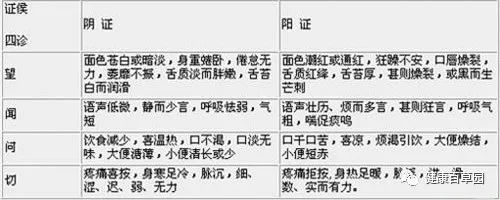
Yang deficiency syndrome: Yang deficiency syndrome is characterized by insufficient Yang energy, leading to a deficiency cold syndrome.
[Clinical manifestations] Pale or sallow complexion, aversion to cold, cold extremities, abdominal pain relieved by pressure, loose stools, clear and frequent urination, shortness of breath, fatigue, pale and tender tongue, and weak or deep, slow pulse.
[Syndrome analysis] The pathogenesis of Yang deficiency syndrome is characterized by insufficient Yang energy, which fails to warm the body, leading to internal cold. Consequently, the functions of the meridians and organs are reduced, and the circulation of qi, blood, and body fluids slows down, leading to internal cold accumulation. Clinical manifestations include aversion to cold, cold extremities, cold pain in the abdomen relieved by pressure, loose stools, clear and frequent urination, pale complexion, fatigue, and weak or deep, slow pulse. Kidney Yang is the root of all Yang, so deficiency of Kidney Yang plays a significant role in the pathogenesis of Yang deficiency. Zhang Jiebin said: “Yang deficiency is due to fire deficiency.” Shen Jinao said: “Yang deficiency is due to true Yang deficiency in the kidneys.”
Loss of Yin syndrome: The life of the human body is centered on Yin and Yang. “Yin is internal, guarding Yang; Yang is external, serving Yin.” “Yin and Yang embrace without separation; ‘Yin is balanced and Yang is secret’ indicates health. When the balance of Yin and Yang is disrupted, leading to excessive or deficient states, disease occurs. Prolonged illness or damage to the righteous qi can lead to the loss of Yin or Yang.
When discussing Yin and Yang in terms of “loss,” it indicates that the disease has progressed to a point where Yin and Yang can no longer maintain balance, and life is in jeopardy. At this critical moment, accurate differentiation of loss of Yin and loss of Yang is crucial.
Loss of Yin syndrome is characterized by extreme depletion of Yin fluids. [Clinical manifestations] Hot and salty sweat, warm hands and feet, aversion to heat, coarse breathing, thirst with a preference for cool drinks, dry tongue without moisture, and thin, rapid pulse.
[Syndrome analysis] Due to excessive consumption of Yin fluids, the Yin energy is on the verge of depletion, leading to manifestations of excessive heat, such as aversion to heat, warm hands and feet, coarse breathing, and thirst with a preference for cool drinks, with hot and salty sweat. Extreme depletion of Yin leads to a thin, rapid pulse.
Loss of Yin can vary in severity; generally, acute loss of Yin is considered critical and often results from external heat invasion. Chronic loss of Yin is less severe and is usually due to prolonged illness.
Loss of Yang syndrome: Loss of Yang syndrome is characterized by weakened Yang energy, leading to a state of impending collapse. [Clinical manifestations] Profuse cold sweat, pale and slightly sticky skin, aversion to cold, cold extremities, weak breathing, lack of thirst or preference for warm drinks, and a floating, rapid, or weak pulse.
[Syndrome analysis] Yang energy is severely damaged, leading to floating and weak cold sweat. Yang energy is weak, resulting in weak breathing; when Yang is weak and Yin is strong, the extremities become cold, and there is a lack of thirst or a preference for warm drinks. The pulse may be floating and large or weak and on the verge of collapse.
Loss of Yang is often due to excessive pathogenic factors overwhelming the righteous qi, leading to sudden loss of Yang energy, or due to pre-existing Yang deficiency where the righteous qi cannot support it, or excessive sweating. Yang is lost with sweat, leading to external loss of Yang energy.Although both Yang deficiency and loss of Yang are characterized by insufficient Yang energy and reduced function, Yang deficiency is a deficiency cold syndrome, while loss of Yang represents a critical state of separation of Yin and Yang.
Yin and Yang must be balanced; thus, loss of Yin leads to loss of Yang, and loss of Yang leads to depletion of Yin. When Yin is lost, Yang has no support and disperses; when Yang is lost, Yin cannot generate and depletes; thus, loss of Yin can quickly lead to loss of Yang, and loss of Yang can subsequently lead to loss of Yin, ultimately resulting in “separation of Yin and Yang, leading to the cessation of life activities and death.”In clinical practice, loss of Yang leading to loss of Yin is relatively rare.

Disclaimer: The article and images are sourced from the internet. If there is any infringement, please contact for removal. The content regarding formulas, acupuncture, and other techniques is for reference only; specific treatments and medications should follow medical advice!
Previous Reviews
-
These 30 commonly used but rarely written Chinese characters, how many do you recognize?
-
Famous TCM practitioner Zhu Jinzong: Treatment for generalized itching and senile pruritus
-
What polyps? It’s just a mass of blood stasis!
-
Do not violently massage blocked milk; a breast doctor teaches you a six-step method to relieve milk stasis
-
Low back and leg pain is not necessarily a herniated disc; beware of piriformis syndrome!
-
Should you wipe after male-female intercourse? Most people make a mistake in the first step.

